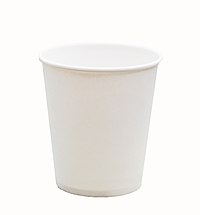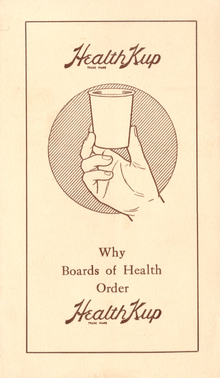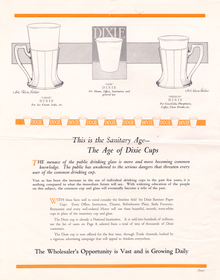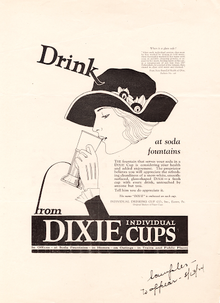Paper cup
This article has multiple issues.Please helpimprove itor discuss these issues on thetalk page.(Learn how and when to remove these messages)
|
Apaper cupis adisposable cupmade out of paper and often lined orcoatedwithplastic[1][2]orwaxto prevent liquid from leaking out or soaking through the paper.[3][4]It may be made ofrecycled paper.[5]
History
[edit]Paper cups have been documented inimperial China,where paper was invented by the 2nd century BC.[6]Paper cups were known aschih peiand were used for the serving of tea.[7]They were constructed in different sizes and colors, and were adorned with decorative designs. Textual evidence of paper cups appears in a description of the possessions of the Yu family, from the city ofHangzhou.[7]
The modern paper cup was developed in the 20th century. In the early 20th century, it was common to have shared glasses or dippers at water sources such as school faucets or water barrels in trains. This shared use caused public health concerns. One notable investigation into their use was the study by Alvin Davison, biology professor atLafayette College,published with the sensational title "Death in School Drinking Cups" inTechnical World Magazinein August 1908, based on research carried out inEaston, Pennsylvania's public schools. The article was reprinted and distributed by the Massachusetts State Board of Health in November 1909.[8]
Based on these concerns, and as paper goods (especially after the 1908 invention of the Dixie Cup) became cheaply and cleanly available, local bans were passed on the shared-use cup. One of the first railway companies to use disposable paper cups was theLackawanna Railroad,which began using them in 1909. By 1917, the public glass had disappeared from railway carriages, replaced by paper cups even in jurisdictions where public glasses had yet to be banned.[9]
Paper cups are also employed in hospitals for health reasons. In 1942 the Massachusetts State College found in one study that the cost of using washable glasses, re-used after being sanitized, was 1.6 times the cost of using single-service paper cups.[10]These studies, as well as the reduction in the risk of cross-infection, encouraged the use of paper cups in hospitals.[citation needed]
Dixie cups
[edit]Dixie Cup is thebrand namefor a line of disposable paper cups that were first developed in the United States in 1907 by Lawrence Luellen, an inventor inBoston,Massachusetts,who was concerned about germs being spread by people sharing glasses or dippers at public supplies of drinking water. Luellen developed an ice-cooled water-vending machinewith disposable cups,[8]and with another Bostonian,Hugh Moore,embarked on anadvertising campaignto educate the public and to market his machine, principally to railroad companies. Professor Davison's study was instrumental in abolishing the public glass and opening the door for the paper cup. Soon, the devices, which would dispense cool water for one cent, became standard equipment on trains.[citation needed]
After Lawrence Luellen invented his paper cup and corresponding water fountain, he started the American Water Supply Company of New England in 1908 located in Boston. The company began producing the cup as well as the Water Vendor. In order to expand their territory, Luellen organized the American Water Supply Company of New York as well as the American Water Supply Company of New Jersey with the help of Hugh Moore. Instead of producing the cups and fountains, these subsidiary companies were charged with the sale and distribution of Luellen's products. In 1909 Luellen and Moore started the Public Cup Vendor Company in New York in order to lease their vendor machines. Their primary customers were railroads so that the devices could be implemented on passenger train cars. After many states started to ban the common drinking cup in public places, steady orders for Luellen's machine began to roll in. The success of Luellen and Moore's territorial companies inspired them to incorporate into the Individual Drinking Cup Company of New York in 1910.[citation needed]

The Dixie Cup was first called "Health Kup", but from 1919 it was named after a line of dolls made by Alfred Schindler's Dixie Doll Company inNew York.Success led the company, which had existed under a variety of names, to call itself the Dixie Cup Corporation and move to a factory inWilson, Pennsylvania.Atop the factory was a large water tank in the shape of a cup.[11]
In 1957, Dixie merged with theAmerican Can Company.TheJames River Corporationpurchased American Can's paper business in 1982. The assets of James River are now part ofGeorgia-Pacific,a subsidiary ofKoch Industries,the second largest privately owned company in the United States. In 1983, production moved to a modern factory in Forks, Pennsylvania. The original factory in Wilson has sat vacant ever since. The closing of the factory also promptedConrailto abandon the Easton & Northern railroad branch, of which Dixie Cups was the last major customer.[citation needed]
In 1969, the Dixie Cup logo was created bySaul Bass,agraphic designerknown for his motion picture title sequences.[12]
Thecoupon collector's problemis sometimes called the Dixie cup problem.[13]
Early advertisements
[edit]The tone of many of the advertisements created by the Dixie Cup Company took the form of embracing modern ideals and marketing towards people who wanted to improve their lives and jump on board a new trend for fear of being left behind. “This is the sanitary age -- the age of dixie cups,”[14][failed verification]was used for several years with success.[citation needed]
A subsequent pivot towards soda fountains was made in both product line and advertising, but the central idea of individual use as more sanitary than reusable glasses persisted. An emphasis on the theme of cups being “touched only by you” was seen as an act to make the cups seem individualized.[citation needed]
Manufacture
[edit]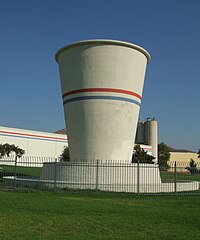
The base paper for paper cups is called "cup board",and is made on special multi-plypaper machines.It has a barrier coating for waterproofing. The paper needs high stiffness and strongwet sizing.The cup board grade has a special design for the cup manufacturing processes. The mouth roll forming process requires good elongation properties of the board and the plastic coating. A well formed mouth roll provides stiffness and handling properties in the cup. The basis weights of the cup boards are 170–350 g/m2.[16]
To meet hygiene requirements, paper cups are generally manufactured from virgin (non-recycled) materials.[citation needed]The one exception to this is when the paper cup features an extra insulating layer for heat retention, which never comes into contact with the beverage, such as a corrugated layer wrapped around a single-wall cup.[citation needed]
Waterproofing
[edit]Originally, paper cups for hot drinks were glued together and made waterproof by dropping a small amount of clay in the bottom of the cup, and then spinning at high speed so that clay would travel up the walls of the cup, making the paper water-resistant.[citation needed]However, this resulted in drinks smelling and tasting of cardboard.[citation needed]
Cups for cold drinks could not be treated in the same way, as condensation forms on the outside, then soaks into the board, making the cup unstable. To remedy this, cup manufacturers developed the technique of spraying both the inside and outside of the cup with wax. Clay and wax-coated cups disappeared with the invention ofpolyethylene(PE)-coated cups; this process covers the surface of the board with a very thin layer of PE, waterproofing the board and welding the seams together.[citation needed]
In 2017, the Finnish board manufacturer Kotkamills launched a new kind of cup (food service) board which uses no wax or plastic for waterproofing, and thus can be recycled as part of the normal paper and board waste stream,biodegraded,or evencompostedin small quantities.[17]
In 2017, the Newport Beach, California, company Smart Planet Technologies, launched "reCUP" for the UK market, a recyclable paper cup using a polyethylene and mineral-blended coating branded EarthCoating, that is engineered to be recycled through traditional paper recycling systems. Paper cups with EarthCoating are sold by Detpak, Huhtamaki, Linstol, and Pureco USA.[citation needed]
Paper cups and paper bags made from "Pinyapel", paper made from discarded pineapple leaves, were introduced in 2019. The water-resistantfood packagingalternative material was developed by a consortium made up of the Department of Trade and Industry Design Center of the Philippines (DCP), Cagayan de Oro Handmade Paper, Nature's Fresh, and Ideatechs Packaging Corporation. The innovation was a Wood Pencil Awardee in the 2019 edition of the annual D&AD Future Impact Awards.[18]Tests by the DCP show that the 55.32 percent mass loss of Pinyapel in four weeks is much higher than the 21.33 percent mass loss in commercial paper bags, giving evidence that the material decomposes faster than other paper products.[19]
Printing on paper cups
[edit]Originally paper cups were printed using rubber blocks mounted on cylinders, with a different cylinder for each colour. Registration across different colours was very difficult, but laterflexographyplates became available and with the use of mounting systems it became easier to register across the colours, allowing for more complex designs. Printing flexographic has become ideal for long runs and manufacturers generally use this method when producing over a million cups. Machines such asComexiare used for this, which have been adapted to take the extra large reels that are required by paper cup manufacturers. Ink technology has also changed and wheresolvent-based inks were being used, water-based inks are instead being utilised. One of the side effects of solvent-based inks is that hot drink cups in particular can smell of solvent, whereas water-based inks have eliminated this problem.[citation needed]
Other methods of printing have been used for short runs such asoffset printing,which can vary within a range from 10,000 to 100,000 cups. Offset printing inks have also been developed and although in the past these were solvent based, the latestsoya-based inkshave reduced the danger of cups smelling. The latest development isDirect-printing,which allows printing on very small quantities, typically from 1,000 cups, and is used by companies including Brendos Ltd offering small quantities in short lead times.Rotogravurecan also be used, but this is extremely expensive and is normally only utilised for items requiring extremely high quality printing like ice cream containers.[20]
Environmental impact
[edit]Recycling
[edit]Most paper cups are designed for a single use and then disposal. Very littlerecycled paperis used to make paper cups because of contamination concerns and regulations. Since most paper cups arecoated with plastic(polyethylene), then both composting and recycling of paper cups is uncommon because of the difficulty in separating the polyethylene in the recycling process of said cups. As of 2016, there are only two facilities in theUKable to properly recycle PE-coated cups; in the absence of such facilities, the cups are taken to landfill or incinerated.[citation needed]
A UK-based business group James Cropper have developed the world's first facility for the effective recycling of the estimated 2.5 billion paper coffee cups used and disposed of by British businesses each year, and have become one of 14 international companies to formally join the Paper Recovery and Recycling Group (PCRRG).[citation needed]
James Cropper's Reclaimed Fibre Facility was opened by HM The Queen in July 2013, and recovers both the plastic and paper from the cups; ensuring nothing is wasted from the recycling process.[21]Although paper cups are made from renewable resources (wood chips 95% by weight), paper products in a landfill might not decompose, or can releasemethane,if decomposedanaerobically.[citation needed]
A US company,Smart Planet Technologieshas developed a new coating on paper cups and folding cartons called EarthCoating so they are certified universally recyclable in conventional paper recycling systems. Paper cups with EarthCoating have received the highest "AAA" rating for recycling from Der Grune Punkt (The Green Dot), a certifying body for recycling in the EU, for recycling in Class 13 bales along with office paper. Smart Planet Technologies' licensee Detpak, along with paper-shredder Shred-X have set up commercial recycling systems for paper cups with EarthCoating, branded "RecycleMe", used in recycled paper products such as copy paper, gift wrap, and paper bags. Detpak declared the takeaway cup problem solved in Australia.[22]Subsequently, Australia's Department of Defense, along with globally-recognized recycler Veolia, have teamed up to recycle the department's paper cups, as part of their "War on Waste".[23]
In 2017, the Finnish board manufacturer Kotkamills launched a new kind of cup (food service) board which uses no wax or plastic for waterproofing, and thus can be recycled as part of the normal paper and board waste stream,biodegraded,or evencompostedin small quantities.[17]
The manufacture of paper usually requiresinorganic chemicalsand creates watereffluents.Paper cups may consume more non-renewable resources than cups made ofpolystyrene foam(whose only significant effluent ispentane).[24][25]
Paper vs plastic
[edit]Alife cycle inventoryof a comparison of paper vsplastic cupsshows environmental effects of both with no clear winner.[26]
Polyethylene(PE) is a petroleum-based coating on paper cups that can slow down the process ofbiodegradingof the paper it coats.[27]
Polylactic acid(PLA) is abiodegradable bio-plasticcoating used on some paper cups. PLA is arenewable resourceand is certified compostable in industrial composting facilities, which means that when it biodegrades, it does not leave behind any toxic residues.[28]Although PLA-lined cups are the only paper cups which can be composted fully, they can contaminate the waste stream, reportedly making other recycled plastics unsaleable.[29]
Before 2012, paper cups could only be recycled at a specialized treatment facility regardless of the lining.[30]
A number of cities – includingPortland,Oregon— have bannedXPS foamcups in take-out and fast food restaurants.[31]
Emissions
[edit]A study of one paper coffee cup with sleeve (16 ounce / 500 ml) shows that the level ofCO2emissionsis about 0.253 kilograms (0.56 lb) per cup with sleeve – including paper from trees, materials, production, and shipping.[32]
Habitat-loss trees used
[edit]Thehabitat lossfrom one 16 ounce paper coffee cup with a sleeve is estimated to be 0.09 square meters (0.93 square feet).[dubious–discuss][33][unreliable source?]Over 6.5 million trees were cut down to make 16 billion paper coffee cups used by U.S. in 2006, using 4 billion US gallons (15,000,000 m3) of water and resulting in 253 million pounds (115,000,000 kg) of waste. Overall, US Americans use 58% of all paper cups worldwide, amounting to 130 billion cups.[21][unreliable source?][34][unreliable source?]
Lids
[edit]Paper cups may have various types of lids. The paper cups that are used as containers for yogurt, for example, generally have two types of lids: heat-sealfoillids used for small "single serving" containers, and 150–200 ml (5–7 US fl oz) plastic press-on, resealable lids used for large "family size" containers, 250–1,000 ml (8–30 US fl oz), where not all of the yogurt may be consumed at any one time and thus the ability to re-close the container is required.[35]
Hot drinks sold in paper cups may come with a plastic lid, to keep the drink hot and prevent spillage. These lids have a hole through which the drink can be sipped. The plastic lids can have many features including peel back tabs, raised walls to protect the foam of gourmet hot drinks and em Boss ed text.[36]In 2008,Starbucksintroduced shaped plastic "splash sticks" to block the hole, in some of their stores, after customer complaints about hot coffee splashing through it.[37][38][39]
References
[edit]- ^"Take-out coffee cups may be shedding trillions of plastic nanoparticles, study says".UPI.Retrieved14 May2022.
- ^Zangmeister, Christopher D.; Radney, James G.; Benkstein, Kurt D.; Kalanyan, Berc (3 May 2022)."Common Single-Use Consumer Plastic Products Release Trillions of Sub-100 nm Nanoparticles per Liter into Water during Normal Use".Environmental Science & Technology.56(9): 5448–5455.Bibcode:2022EnST...56.5448Z.doi:10.1021/acs.est.1c06768.ISSN0013-936X.PMID35441513.S2CID248263169.
- ^Kennedy, Garry:Dixie Cupentry, Apollo Glossary, NASA. Retrieved 2012-02-06.
- ^"Paper Products & Dispensers".Toiletpaperworld. Archived fromthe originalon 2013-02-04.Retrieved2007-06-09.
- ^Raloff, Janet (2006-02-11)."Wind Makes Food Retailers Greener".Science News.
- ^Tsien, Tsuen-Hsuin(1985). Joseph Needham (ed.).Paper and Printing.Science and Civilisation in China, Chemistry and Chemical Technology. Vol. 5 part 1. Cambridge University Press. p. 38.
- ^abJoseph Needham (1985).Science and Civilisation in China: Paper and Printing.Cambridge University Press. p. 122.ISBN978-0-521-08690-5.
At this time tea was served from baskets made of rushes which held... a set of several tens of paper cups (chih pei) in different sizes and colors with delicate designs
- ^abcd"Dixie Cup Company History".Lafayette College Libraries. August 1995. Archived fromthe originalon 2011-11-12.
- ^White, John H.(1985) [1978].The American Railroad Passenger Car.Vol. 2. Baltimore, Maryland:Johns Hopkins University Press.p. 432.ISBN978-0-8018-2747-1.
- ^Beulah France (February 1942). "Uses for Paper Cups and Containers".The American Journal of Nursing.42(2): 154–156.doi:10.2307/3416163.JSTOR3416163.S2CID220566845.
- ^Former Dixie Cup Factory, Wilson, Pa(photograph)
- ^Lewis, Andy (November 8, 2011)."Movie and Logo Designer Saul Bass Celebrated with Book, MoMA Event".The Hollywood Reporter.RetrievedAugust 4,2023.
- ^Newman, Donald J.;Shepp, Lawrence(1960), "The double dixie cup problem",American Mathematical Monthly,vol. 67, no. 1, pp. 58–61,doi:10.2307/2308930,JSTOR2308930,MR0120672
- ^"Whistlin' Dixie: Marketing the Paper Cup, 1910-1960".sites.lafayette.edu.Retrieved2019-05-18.
- ^"Lily-Tulip Cup Corporation, Springfield-Greene County Library, Springfield, Missouri".
- ^Savolainen, Antti (1998). "6".Paper and Paperboard Converting.Papermaking Science and Technology. Vol. 12. Finland: Fapet OY. pp. 170–172.ISBN978-952-5216-12-7.
- ^ab"Suomalainen yritys teki sen – kahvin, rasvan ja oluen kestävät muovittomat ihmepahvit lähtevät maailmalle:" Kiinnostus on valtavaa ""[A Finnish company made it – plastic-free miracle board that can withstand coffee, fat and beer: "We have received huge interest" ]. YLE.Retrieved1 September2017.
- ^"Pinoy-made 'Pinyapel' wins environment and sustainability award in New York".30 October 2019.
- ^"Filipinos Made This Plastic-Free Cup From Pineapple Leaves".vice.
- ^"Rotogravure Printing for Ice Cream Containers".LuxPack GCC.Retrieved30 September2024.
- ^ab"Paper Cups = Unsustainable Consumption".aboutmyplanet. Archived fromthe originalon June 6, 2008.RetrievedFebruary 6,2008.
- ^"Detpak - Takeaway Cup Recycling Solved in Australia".detpak.Retrieved2021-04-07.
- ^"Veolia and Defence join together to eliminate single-use disposable cups".Veolia Australia and New Zealand.Retrieved2021-04-07.
- ^Don R. Hansen & Maryanne M. Mowen (2005).Management Accounting: The Cornerstone of Business Decisions.Thomson South-Western. p. 503.ISBN978-0-324-23484-8.
- ^Chris T. Hendrickson; Lester B. Lave & H. Scott Matthews (2006).Environmental Life Cycle Assessment of Goods and Services: An Input-output Approach.Resources for the Future. p. 5.ISBN978-1-933115-23-8.
- ^Hocking, M. B. (1 February 1991). "Paper Versus Polystyrene: A Complex Choice".Science.251(4993n): 504–5.Bibcode:1991Sci...251..504H.doi:10.1126/science.251.4993.504.PMID17840849.S2CID33293105.
- ^"PE Paper Coating".Retrieved2024-08-13.
- ^"Composting".Retrieved2013-10-15.
- ^"Sustainable bio-plastic can damage the environment".TheGuardian.25 April 2008.Retrieved2017-06-21.
- ^"Paper Cup Recycling".Retrieved2012-02-01.
- ^Helfrich, M. William; Sanders, Justin Wescoat (2003-08-13)."The Coming Cup-tastrophe".The Portland Mercury.
- ^"Report of the Alliance for Environmental Innovation"(PDF).edf. Archived fromthe original(PDF)on 2015-09-20.Retrieved2008-02-06.
- ^"ecological effects of a paper cup".ecofx.org. Archived fromthe originalon August 9, 2010.RetrievedFebruary 6,2008.
- ^Spitzer, Nina (30 July 2009)."The impact of disposable coffee cups on the environment".Retrieved21 November2012.
- ^Adman Y. Tamime & Richard K. Robinson (1999).Yoghurt: science and technology.Woodhead Publishing. p. 97.ISBN978-1-85573-399-2.
- ^"The Rise of the Plastic, Disposable Coffee Cup Lid".The Atlantic. 9 May 2011.Retrieved3 March2017.
- ^"Starbucks splash stick says no to sploshing".USA Today. 14 March 2008.Retrieved21 April2016.
- ^Johnson, Steve (11 March 2016)."Solving the mystery of Starbucks little green sticks".Chicago Tribune.Retrieved21 April2016.
- ^"Example of awareness campaign for availability of splash sticks".JustGiving. 19 October 2015.Retrieved16 August2023.
Bibliography
[edit]- Allyn Freeman & Bob Golden (1997)."Little Dipper".Why Didn't I Think of That?: Bizarre Origins of Ingenious Inventions We Couldn't Live Without.John Wiley and Sons. pp.183–184.ISBN978-0-471-16511-8.– the Dixie Cup
- Maying Soong (2002).Chinese Paper Folding for Beginners.Courier Dover Publications. pp. 6–7.ISBN978-0-486-41806-3.– how to make a paper cup out of a square of paper usingorigami
- Martin B. Hocking (November 1991). "Relative merits of polystyrene foam and paper in hot drink cups: Implications for packaging".Environmental Management.15(6). Springer New York: 731–747.Bibcode:1991EnMan..15..731H.doi:10.1007/BF02394812.S2CID137050319.
- Martin B. Hocking (November 1994). "Reusable and disposable cups: An energy-based evaluation".Environmental Management.18(6). Springer New York: 889–899.Bibcode:1994EnMan..18..889H.doi:10.1007/BF02393618.S2CID30427571.
- A mathematically annotated folding instruction for paper cups
External links
[edit] Media related toPaper cupsat Wikimedia Commons
Media related toPaper cupsat Wikimedia Commons- Paper cup machine

